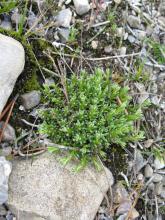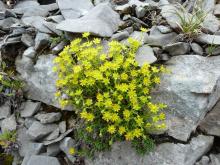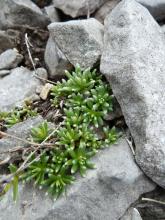Gulsildre ("yellow saxifrage", Saxifraga aizoides) is common along mineral rich seepage lines in the alpine zone. The common color is yellow but you often encounter populations with orange or even near red flowers.
Gulsildre ("yellow saxifrage", Saxifraga aizoides) is common along mineral rich seepage lines in the alpine zone. The common color is yellow but you often encounter populations with orange or even near red flowers.
Comments
Trond Hoy
Re: Not always yellow...
Mon, 07/26/2010 - 2:32amTwo more
Trond Hoy
Re: Not always yellow...
Mon, 07/26/2010 - 5:19amYellows
Todd Boland
Re: Not always yellow...
Mon, 07/26/2010 - 9:13amThat is another native species common in the limestone regions of northern newfoundland...however, I have only ever seen them in yellow. The orange form is lovely! One of our local members has a red form which is stunning as well.
Lori S. (not verified)
Re: Not always yellow...
Mon, 07/26/2010 - 9:36pmI've only noticed yellow ones in the wild here so far also. The orange ones are spectacular!
Lori S. (not verified)
Re: Not always yellow... Saxifraga aizoides
Sat, 01/28/2012 - 3:13pmHere are some local examples of Saxifraga aizoides.



Flora of Alberta notes its habitat as "alpine streams and talus". However, one doesn't have to hike the high country to find it in this area, as it occurs down to fairly low elevations, for example, along the gravel floodplain of the Big and Little Elbow Rivers in Kananaskis and along the roadcuts and gravelly streamsides along Highway 93. The foliage, which Malcolm McGregor notes as "leaves more or less cylindrical" in his Saxifrages, is quite distinctive and recognizable among the other alpines that occur here.
Trond Hoy
Re: Not always yellow... Saxifraga aizoides
Sat, 01/28/2012 - 11:41pmLori, those plants seem to grow rather dry?
It's common on taluses here too but only the wet ones along watercourses or seepings.
This species reminds me of a Sedum, not a Sax.
Mark McDonough
Re: Not always yellow... Saxifraga aizoides
Sun, 01/29/2012 - 7:35amI really like the orange ones, stunning color. But I would be ever so happy to even grow a yellow one like the fine cushion that Lori showed. I suspect there is moisture under the surface rocky detritus. These do indeed have a very sedum-like quality to them.
Trond Hoy
Re: Not always yellow... Saxifraga aizoides
Sun, 01/29/2012 - 9:03amWell, Mark, all you have to do is to build a little watercourse (and don't forget - it has to be calcareous or at least mineral rich water). ;)
Lori S. (not verified)
Re: Not always yellow... Saxifraga aizoides
Sun, 01/29/2012 - 9:40amThe plant in one of those photos is above the level of any obvious surface water flow but may very well have its roots down to a level where seepage moves through.
cohan (not verified)
Re: Not always yellow... Saxifraga aizoides
Mon, 01/30/2012 - 10:25pmI've seen the orange ones in photos- very nice! but have not seen it in person... I've seen the plant (yellow only) up (very) near the Athabasca Glacier at the Columbia Icefield site, where it was growing mostly alone, presumably a pioneer species, and much lower also, as Lori mentions, at the edge of a -lake? pond? that I've shown before, with Primula mistassinica, Tofieldia glutinosa etc... I have a little patch of this in a pot from a cutting from that site..
I forgot to add, they were always in wet gravelly and/or clayey soils where I saw them (the pond area is probably drier at times, but likely always moist down a bit farther).. I keep my pot standing in a saucer of water (its in a pot since I have not made a wet section of a bed to plant them yet..I may do something similar to the pot on a larger scale- soil/stones rising a bit out of some sort of container sunk in the soil which will hold water..
Trond Hoy
Re: Not always yellow... Saxifraga aizoides
Tue, 01/31/2012 - 9:08amIn Northern Norway many montane plants grow down to the sea level. Last summer when I visited Andøya (70oN) for a week. Saxifraga aizoides was common almost at the beach.
In Southern Norway it follows streams and rivers down to the coast some places. The yellow form is the commoner but orange or almost red forms exist too.